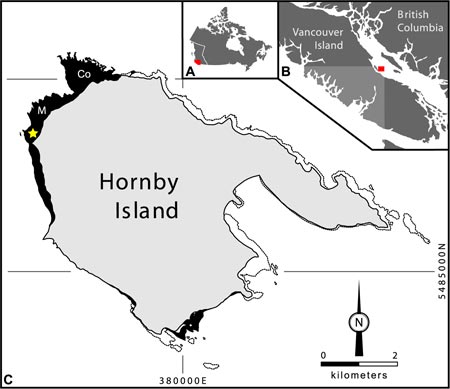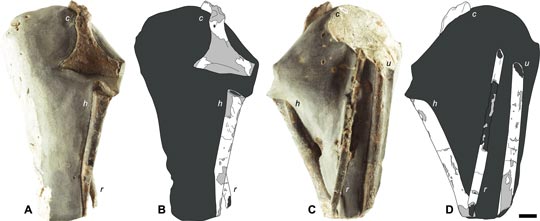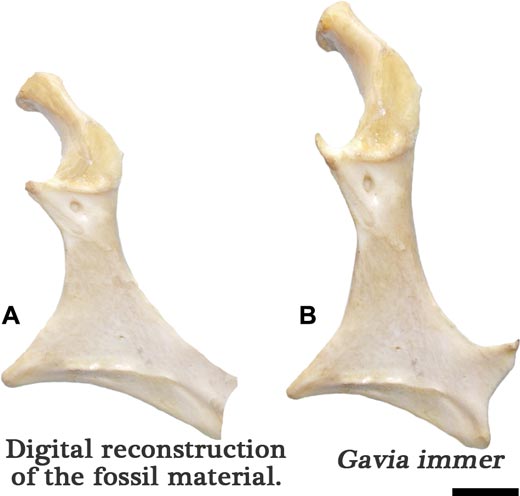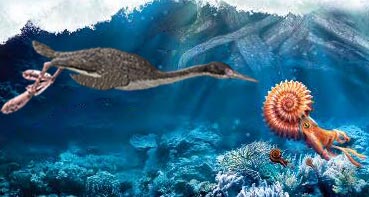Water Bird from the Late Cretaceous Identified in New Research
Maaqwi cascadensis – Diving Bird from the Late Cretaceous
A team of scientists writing in the on-line academic journal PLOS One have named a new species of Late Cretaceous marine bird, based on a single coracoid bone and some fragments representing bones from the wing. The animal has been named Maaqwi cascadensis and at an estimated 1.5 kilos in weight it was about the same size as your average domestic chicken. However, this bird is believed to have been adapted to a marine environment, using its legs to paddle around under water in pursuit of fish.
Maaqwi cascadensis
Fossils of birds from the Pacific Coast of North America are exceptionally rare, these marine deposits that form part of the Northumberland Formation have yielded fossil fish, marine reptile remains plus fragmentary elements of terrestrial animals including dinosaur bones, but very few avian fossils. M. cascadensis was discovered on Hornby Island. The strata are estimated to represent Late Campanian to Early Maastrichtian deposits (around 73 to 71 million years old). The fossil specimen consists of a mudstone concretion which contains a right coracoid bone plus fragmentary wing bones (humerus, ulna and radius).
A Map Showing the Location of Hornby Island in British Columbia and the Fossil Site

Picture credit: PLOS One
In the picture above (A) provides the geographical setting of British Columbia in Canada, whilst (B) shows the location of Hornby Island in the context of Vancouver Island. The larger map (C) shows Hornby Island with the Northumberland Formation exposures highlighted in black. The yellow star in (C) shows the location of the fossil discovery.
An initial description of the fossil material had been published previously (2011), but it was only with further cleaning and preparation that the full extent of the fossil material became known.
Photographs and Accompanying Line Drawings of the Fossil Material

Picture credit: PLOS One
In the picture (above) photograph (A) shows the dorsal face of the right coracoid and the partial humerus (c and h) with an accompanying line drawing (B). Photograph (C) shows the reverse side of the fossil (ventral) revealing more of the wing bones (u = ulna and r = radius). A line drawing of the reverse side of the fossil is provided (D). Note the scale bar (1 cm). In the line drawings white shading denotes preserved cortical bone (dense bone found towards the outside of bones), whilst the light grey shading shows exposed trabecular bone (spongy internal bone). The dark grey/black represents the mudstone matrix.
Robust Bones and Short Wings
The size of the coracoid bone suggests a large bird, one weighing around 1.5 kilos. The bones are robust with thickened walls, suggesting that this prehistoric bird was adapted for diving, such as modern grebes and loons. The coracoid (part of the shoulder bones), is very reminiscent of the coracoid of extant diving birds (Gavia immer – the Common Loon).
A Comparison of Coracoid Bones M. cascadensis Compared to Gavia immer

Picture credit: PLOS One with additional notation by Everything Dinosaur
An assessment of the arm bones (ulna, radius and humerus) suggests that M. cascadensis had short wings. It is not known whether this bird was flightless, the wings were probably not the main means of propulsion through water. It has been speculated that the feet were used to propel the bird underwater, in a similar way to the swimming action of cormorants, if this is the case, then Maaqwi probably had webbed feet.
The research team propose that this bird was a member of the Ornithurae, a natural group which includes the common ancestor of Ichthyornis, Hesperornis and all modern birds. The generic name, Maaqwi, is derived from “ma’aqwi”, from the language of the indigenous Coast Salish people of the North-west Pacific. The word means “water bird”. The specific name or trivial name, cascadensis, reflects provenance in the Cascadia region of western North America.
A Sister Taxon to Vegavis iaai?
The scientists including Nicholas Longrich (University of Bath), propose that Maaqwi cascadensis might have been a sister taxon to Vegavis iaai of the Antarctic and along with the Ichthyornithes and Hesperornithes, M. cascadensis and Vegaviidae appear to represent a third clade of bird that evolved to exploit marine habitats in the Late Cretaceous.
To read an article about the voice box of Vegavis iaai: Ancient Bird Voice Box Sheds Light on the Voices of Dinosaurs.
A Speculative Illustration of a Diving Maaqwi cascadensis

Picture credit: Everything Dinosaur
Visit the Everything Dinosaur website: Everything Dinosaur.

